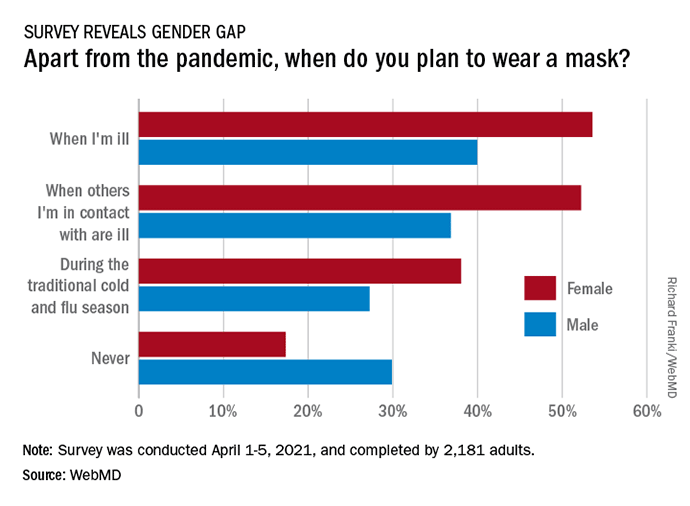quantos comprimidos de aciclovir devo tomar por dia

Editor’s note: Find the latest COVID-19 news and guidance in Medscape’s Coronavirus Resource Center.
Answers ranged from “while recommended by public health experts” to “never” regarding the wearing of masks during and after the COVID-19 pandemic in a new WebMD survey. Significant differences emerged between women and men, as well as by age.
A much higher percentage of women plan to wear a mask because of COVID-19 as long as public health experts such as those at the Centers for Disease Control and Prevention recommend it — 73%, compared with 63% of men.
In contrast, 6% of women and 11% of men said they do not wear a mask, although the absolute number who provided this answer was smaller: 126 people.
Their answers are among responses from 1557 WebMD readers who were surveyed from April 1 to April 5, 2021. A total of 2181 adults participated in all or part of the survey.
Other responses to the question, “How long do you plan to routinely wear a mask due to COVID-19?” included, “until I’m fully vaccinated.” A total of 131 respondents chose this answer, smoking zoloft including 5% of women and 9% of men. The difference by gender was statistically significant at the 95% confidence level.
Only nine people indicated that they would wear a mask until they receive the first dose of one of the available mRNA vaccines. Another 176 respondents said they would wear a mask as long as their workplace or school required it; 8% of women and 10% of men responded in that way.
Another 166 people chose “other” when asked how long they would wear a mask because of COVID-19, including 7% of women and 6% of men. Respondents had the option to explain this choice. Comments included “forever,” “long term,” and “For the rest of my entire life. Not joking either.” Other explanations included “until I feel safe,” “if required in a business that I enter,” and “until fully vaccinated.”
Mask After COVID-19?
The survey also asked: “Apart from the COVID pandemic, at what other times do you plan to wear a mask in the future?” Unlike the first question, in which people could only select one response, for this question, respondents could select all answers that applied.

With the exception of “other,” all answers differed significantly between men and women.
For example, 38% of women and 27% of men plan to wear a mask during the traditional cold and flu season.
Also, 54% of women and 40% of men plan to don a mask “when ill.” A slightly lower proportion indicated that they will wear a mask when others are ill, 52% of women and 37% of men.
Furthermore, 47% of women and 37% of men plan to wear a mask in crowded public places. Asked about public transportation, 34% of women and 26% of men plan to put on a mask.
Interestingly, 17% of women and 30% of men said they plan to never wear a mask apart from the COVID-19 pandemic.
Some of the 8% of women and 7% of men who chose “other” expanded on their answer. “When I feel it’s necessary,” “not sure,” and “at the doctor’s office” were among the responses.
Answers by Age
Responses to the two survey questions also varied by age. The survey classified age into three cohorts: younger than 35, 35 to 54, and 55 and older.
The only significant difference among all age cohorts was people who indicated “do not wear a mask” in response to the first question about how long they plan to wear a mask because of COVID-19. The breakdown was 11% of those under 35, 9% of those between 35 and 54, and 4% of the older age cohort.
Those who said they never plan to wear a mask after the COVID-19 pandemic included 22% of the younger group, 25% of those 35 to 54, and 17% of the 55-and-older group.
Older respondents to the second question also indicated that they plan to take more precautions in crowded locations ― 50% of the 55-and-older group plan to wear a mask, compared with 41% of the middle-age group and 38% of the younger group.
The intercept survey answers were weighted by age and gender to better represent WebMD readers. Responses were evaluated by state and region of the United States, but no significant patterns emerged. The margin of error was ±2.10%. The total number of responses was based on unweighted data.
Damian McNamara is a staff journalist based in Miami. He covers a wide range of medical specialties, including infectious diseases, gastroenterology and neurology. Follow Damian on Twitter: @MedReporter.
For more news, follow Medscape on Facebook, Twitter, Instagram, and YouTube.
Source: Read Full Article